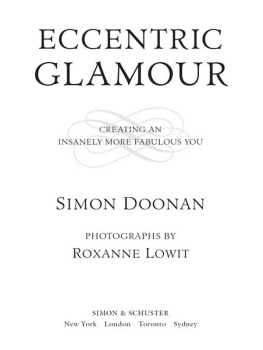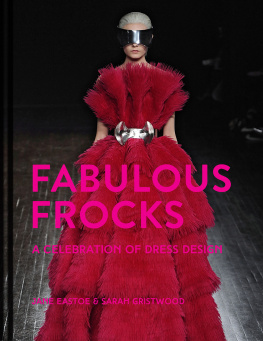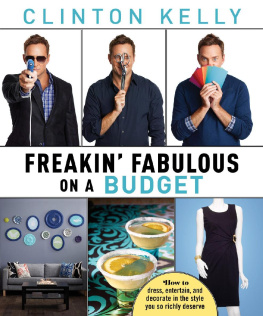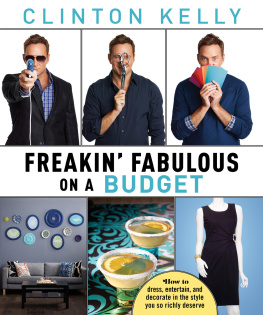FABULOUS
MADISON MOORE FABULOUS THE RISE OF THE BEAUTIFUL ECCENTRIC

Copyright 2018 by madison moore.
All rights reserved.
This book may not be reproduced, in whole or in part, including illustrations, in any form (beyond that copying permitted by Sections 107 and 108 of the U.S. Copyright Law and except by reviewers for the public press), without written permission from the publishers.
Yale University Press books may be purchased in quantity for educational, business, or promotional use. For information, please e-mail sales.press@yale.edu (U.S. office) or sales@yaleup.co.uk (U.K. office).
Designed by Sonia L. Shannon.
Set in Futura type by Tseng Information Systems, Inc.
Printed in the United States of America.
Library of Congress Control Number: 2017957274
ISBN 978-0-300-20470-4 (hardcover : alk. paper)
This paper meets the requirements of ANSI/NISO Z39.48-1992 (Permanence of Paper).
10 9 8 7 6 5 4 3 2 1
CONTENTS
1.
The Rise of the Beautiful Eccentric
2.
How to Work a Look
3.
Up in the Club
4.
Whats Queer about the Catwalk?
Dont Hate Us Cause We Fabulous
900 Words on Prince
PREFACE
the story of fabulousness was on my mind way before I knew it would become a whole book. It was on my mind when I rushed to Casa Magazines on the corner of 8th Avenue and 12th Street in New York City every month to get the latest issues of French and Italian Vogue. It was on my mind when I saw my grandmother get all dressed up for church or the casinowigs, broaches, sequins, and all. And as a teenaged gay boy I locked myself in my bedroom and plugged into this book as I danced to Prince and Lenny Kravitz, two black men who fascinated me because they could wear leather pants, fringe, and high heels, and nobody seemed to mind all that much. How do they do it? I wondered. Almost twenty years later here I am, posing the same question.
There are some books you read that really stick with you over the course of your lifetime, and for me The Theory of the Leisure Class, a canonical book by the Yale-trained economist Thorstein Veblen, published in 1899, is one of those books. Its a breezy, satirical portrait of the white, straight, new-moneyed elite of the Gilded Age, the book that birthed the term conspicuous consumption. Today, Veblens little book seems as relevant in Trumps America as it did more than a hundred years ago, as the Minnesotan author was primarily interested in, or more like disgusted by, grotesque displays of wealth. He understood the conspicuousness of luxury, fancy clothes, big houses, and decadent feasts as limitless, never-ending examples of power and financial prowess. Sound familiar? But the story of conspicuousness Im telling here is much more brown, much more queer, and a lot more fun. The pursuit of fun and pleasure are political gestures too. This bedazzled revision of Veblen is about how fashion, glitter, and sequins, things I cant get enough of, are not only shiny, conspicuous, and look great on Instagram, but they underscore the pleasure and power of creativity for queer and marginalized people and other social outcasts. The story Im telling is about fabulousness as a queer aesthetic, an essence that allows marginalized people and social outcasts to regain their humanity and creativity, not necessarily to boast about power or influence.
Veblens original text is, at its heart, about the wasteful nature of capitalism and the leisure class that spills out of it. He was curious about how the conspicuous consumption of goods was used to wield financial prowess over people of considerably less influence and social value. Think, for instance, of the nineteenth-century socialite Caroline Schermerhorn Astor, the Mrs. Astor, who threw exclusive parties at her home on Fifth Avenue, ruled the New York social scene, and was rumored to keep a List of 400the only four hundred people in all of the city who mattered. These parties were definitely about performing a certain kind of conspicuous consumption. But were there any brown people at the functions?
In revising Veblens original ideas about conspicuous consumption and power I want to tell a different side of the story. I want to talk about how fabulousness is not about money but about opening doors to brand-new dimensions, creating a separate space in the here and now. The challenge of telling the story of fabulousness is that there is no single, traditional archive specifically dedicated to it. There is no single university or museum that holds the definitive record on material related to fabulousness as it has spread and been experienced across time, communities, and space. Fabulousness is everywhere, but it is not necessarily right in front of us at all times. It flashes before our eyes for brief moments at a time, seducing us emotionally. Thats what makes it exciting. Its a type of creative engagement we can find everywhere: from Balzacs realist fiction and writings on fashion, like his 1836 novel Old Goriot or his 1830 Treatise on Elegant Living, to the more contemporary cultural forms of performance art, voguing, and club culture.
Fabulous: The Rise of the Beautiful Eccentric is not a manifesto. Not everyone needs to be fabulous all the time, and there are certainly millions of people who dont want to or cant be fabulous for one reason or another. But what is compelling about fabulousness are the people who consciously chose the harder route, the risk and the rise of living as a spectacle, when it would be so much easierthough no less toxicto just follow the rules and blend in. This book tells their stories.
1.
The Rise of the Beautiful Eccentric
i will never forget the day I saw the Juilliard-trained queer virtuoso violinist Amadus Leopold (formerly Hahn-Bin) live in concert. It was his first downtown show, a special performance handpicked by Lou Reed and Laurie Anderson at a tiny experimental music and performance art venue in New York called the Stone. At the time, Leopold, who had studied violin with the legendary Itzhak Perlman at Juilliard, pumped around the classical music, fashion, and art worlds in New York City, making a splash with his blend of unquestionable virtuosity, his thrilling sense of performance, his fashion and creative strangeness. He took classical music from Alice Tully Hall to MoMA and from the catwalk to the nightclub. Id been assigned to write a story about him for Interview magazine, and the fashion diva and classical music nerd in me was eager to see him in action. Its hard to convey how much Leopolds art spoke to me: I also grew up in the violin world of orchestra, summer music camps, recitals, and competitions, even earning a full ride to a school of music for violin performance. But in my two decades of studying violin I always felt something wasnt quite right. Where was the diversity? Americas homegrown heartthrob virtuoso Joshua Bell is great, and so are other star performers like Midori and Anne-Sophie Mutter. But where was the fabulous brown queen behind the violin?
As soon as I learned about Amadus Leopold I exhaled. At last, an unapologetically queer classical violin virtuoso! What drew me to Leopold wasnt just that he had studied with Perlman at Juilliard, so he must be good. It was that he really knows how to work a look. Take one glance at Leopold and youll see that fashion is just as much a part of his art as the music he plays. When I got to meet him for the
Next page









